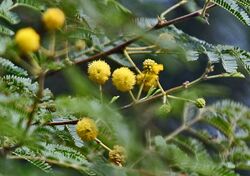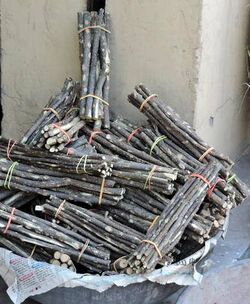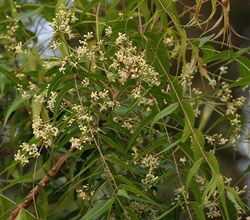Engineering:Teeth-cleaning twig
A teeth-cleaning twig (in India: datun[1]) is an oral hygiene tool made from a twig from a tree. It can help to prevent tooth decay and gum disease.
History
Chew sticks are twigs or roots of certain plants that are chewed until one end is frayed. This end can be used to brush against the teeth,[2] while the other end can be used as a toothpick.[3] The earliest chew sticks have been dated to Babylonia in 3500 BCE[3] and an Egyptian tomb from 3000 BCE;[2] they are mentioned in Chinese records dating from 1600 BCE[3] In the Ayurvedas around 4th century BCE and in Tipitaka, in the Buddhist Canon around the 5th century BCE in India.[4][5]
The Indian way of using tooth wood for brushing is presented by the Chinese Monk Yijing (635–713 CE) when he describes the rules for Monks in his book:[6]
Every day in the morning, a monk must chew a piece of tooth wood to brush his teeth and scrape his tongue, and this must be done in the proper way. Only after one has washed one’s hands and mouth may one make salutations. Otherwise both the saluter and the saluted are at fault. In Sanskrit, the tooth wood is known as the dantakastha—danta meaning tooth, and kastha, a piece of wood. It is twelve finger-widths in length. The shortest is not less than eight finger-widths long, resembling the little finger in size. Chew one end of the wood well for a long while and then brush the teeth with it.
A wide variety of plants can be used as dantakastha.[7]
In Africa, chew sticks are made from the tree Salvadora persica, also known as the "toothbrush tree". In Islam, this tree is traditionally used to create a chew stick called miswak, as frequently advocated for in the hadith (written traditions relating to the life of Muhammad).[8]
In South India, neem is used as a teeth cleaning twig. Neem, in full bloom, can aid in healing by keeping the area clean and disinfected.
Traditional Sikhs still use datun today as it is written in their scriptures:
ਦਾਤਨ ਕਰੇ ਨਿਤ ਨੀਤ ਨਾ ਦੁਖ ਪਾਵੈ ਲਾਲ ਜੀ ॥ (੨੩)
("Dear/beloved, natural twig, brush everyday, and pains you shall never get." (23))
Twigs used

Teeth-cleaning twigs can be obtained from a variety of tree species. Although many trees are used in the production of teeth-cleaning twigs, some trees are better suited to clean and protect the teeth, due to the chemical composition of the plant parts. The tree species are:[9][10][11][12][13][14]
- Salvadora persica
- Sassafras
- Gumtree[15]
- Lime tree (Citrusaurantafolia)[16]
- Garcinia mannii in West Africa[17]
- Orange tree (Citrus × sinensis)[16]
- African laburnum (Cassia sieberiana)[16]
- Tea tree
- Neem in the Indian subcontinent
- Vachellia nilotica, also called babool or kikar in the Indian subcontinent
- Dalbergia sissoo, also called sheesham in the Indian subcontinent
- Liquorice
- Gouania lupuloides
- Cinnamon
- Dogwood
- Olive
- Walnut
- Acacia catechu
- Acacia nilotica
- and other trees with bitter roots.
Europe and North America
- Apple
- Pear
- Bamboo
- Fig tree
- Hazelnut
- Willow
- Orange
- Lime
- Silver birch
- Olive
- Walnut
- Liquorice root
- Nyssa sylvatica
Australia
India
- Apamarga
- Arjun
- Bael
- Bargad
- Ber
- Dhak
- Gular
- Jamun
- Kamer
- Karanj
- Madar ak
- Mango
- Mulhatti
- Neem
- Peepal
- Safed babul or Acacia
- Tejovati
- Vijayasar
Carrying
Many companies produce special cases for carrying, storing and protecting chew sticks, known popularly as "miswak holders".
Advantages
When compared to toothbrushes, teeth-cleaning twigs have several advantages:Template:Unbalanced opinion
- More ecological in its life-cycle
- Lower cost (0–16% of the cost of a toothbrush[15])
- Independence from external supplier if made at home from privately owned trees
- Low maintenance, with some twigs needing moistening with water if they become dry, to ensure the end is soft. The end may be cut afresh to ensure hygiene, and should not be stored near a sink. The twig is replaced every few weeks to maintain proper hygiene.
- No need for toothpaste
On the other hand, different species of trees have various levels of hardness just as synthetic toothbrushes would, so careful selection of the right hardness is required before use. Excessive scrubbing too can also bring the risk of gum damage, though this is a concern for plastic toothbrushes as well.[15]
See also
References
- ↑ Winer, Lise (2009). Dictionary of the English/Creole of Trinidad & Tobago. McGill-Queen's. p. 285. ISBN 978-0-7735-7607-0. https://books.google.com/books?id=_n82hsbDJBMC&pg=PA285. "[Bhojpuri] Script error: The function "transl" does not exist., Script error: The function "transl" does not exist., [Hindi] Script error: The function "transl" does not exist. 'toothbrush; twig for cleansing the teeth'"
- ↑ 2.0 2.1 Panati, Charles (2013). Extraordinary Origins of Everyday Things. HarperCollins. pp. 208–209. ISBN 978-0-06-227708-4. https://books.google.com/books?id=U662rR2VInQC&pg=PA208.
- ↑ 3.0 3.1 3.2 Yu, Hai-Yang; Qian, Lin-Mao; Zheng, Jing (2013). Dental Biotribology. Springer. pp. 18–19. ISBN 978-1-4614-4550-0. https://books.google.com/books?id=tsSqVeaHUv0C&pg=PA19.
- ↑ Dantakaṭṭha sutta (AN 5.208) Mahāsaṅgīti Tipiṭaka Buddhavasse 2500
- ↑ Singh, Abhinav; Purohit, Bharathi (2011). "Tooth brushing, oil pulling and tissue regeneration: A review of holistic approaches to oral health". Journal of Ayurveda and Integrative Medicine 2 (2): 64–68. doi:10.4103/0975-9476.82525. PMID 21760690.
- ↑ Li, R., 2000. Buddhist Monastic Traditions of Southern Asia: A Record of the Inner Law Sent Home from the South Seas (p. 198). Numata Center for Buddhist Translation and Research.
- ↑ Dantakasthas (Chewing Sticks) in Ayurveda: A Review. doi:10.31031/ACAM.2018.02.000536. https://www.researchgate.net/publication/326622378.
- ↑ "Search Results - miswak (page 1) - Sunnah.com - Sayings and Teachings of Prophet Muhammad (صلى الله عليه و سلم)". sunnah.com. http://sunnah.com/search/miswak.
- ↑ "Neem tree as teeth cleaning twig". Batplants.co.uk. http://www.batplants.co.uk/neemtree.htm.
- ↑ "Natural twigs used as teeth cleaning twigs". Naturaltoothbrush.com. http://www.naturaltoothbrush.com/.
- ↑ "Neem tree as teeth cleaning twig 2". Neem-products.com. http://www.neem-products.com/neem-twig.html.
- ↑ "Natural toothbrush twigs". Naturallygreen.co.uk. 2007-09-15. http://www.naturallygreen.co.uk/natural-toothbrush-twig-natural-p-122.html.
- ↑ "Natural toothbrush overview". Nzherald.co.nz. 2007-06-19. http://www.nzherald.co.nz/dental-care/news/article.cfm?c_id=1500935&objectid=10446594.
- ↑ "Xuanzang (玄奘) <603 - 664>: Buddhist records of the Western world (大唐西域記), book VIII/IX.". http://www.payer.de/quellenkunde/quellen122.htm.
- ↑ 15.0 15.1 15.2 Fletcher, Pascal (19 June 2007). "African twig brushes offer all-day dental care". NZME. http://www.nzherald.co.nz/dental-care/news/article.cfm?c_id=1500935&objectid=10446594.
- ↑ 16.0 16.1 16.2 Ra'ed I. Al Sadhan, Khalid Almas (1999). "Miswak (chewing Stick): A Cultural And Scientific Heritage.". Saudi Dental Journal 11 (2): 80–88.
- ↑ Cheek (2004)
 |




